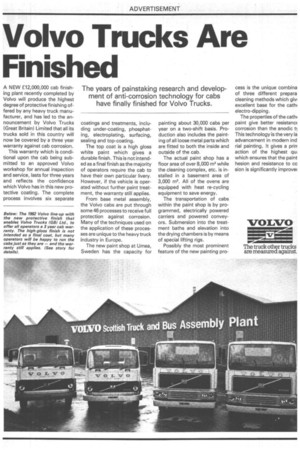Volvo Trucks Are Finished
Page 33

If you've noticed an error in this article please click here to report it so we can fix it.
The years of painstaking research and development of anti-corrosion technology for cabs have finally finished for Volvo Trucks. A NEW E12,000,000 cab finishing plant recently completed by Volvo will produce the highest degree of protective finishing offered by any heavy truck manufacturer, and has led to the announcement by Volvo Trucks (Great Britain) Limited that all its trucks sold in this country will now be covered by a three year warranty against cab corrosion.
This warranty which is conditional upon the cab being submitted to an approved Volvo workshop for annual inspection and service, lasts for three years and reflects the confidence which Volvo has in this new protective coating. The complete process involves six separate coatings and treatments, including under-coating, phosphating, electroplating, surfacing, sealing and top-coating.
The top coat is a high gloss white paint which gives a durable finish. This is not intended as a final finish as the majority of operators require the cab to have their own particular livery. However, if the vehicle is operated without further paint treatment, the warranty still applies.
From base metal assembly, the Volvo cabs are put through some 46 processes to receive full protection against corrosion. Many of the techniques used on the application of these processes are unique to the heavy truck industry in Europe.
The new paint shop at Umea, Sweden has the capacity for painting about 30,000 cabs per year on a two-shift basis. Production also includes the painting of all loose metal parts which are fitted to both the inside and outside of the cab.
The actual paint shop has a floor area of over 8,000 m2 while the cleaning complex, etc. is installed in a basement area of 3,000 m2. All of the ovens are equipped with heat re-cycling equipment to save energy.
The transportation of cabs within the paint shop is by programmed, electrically powered carriers and powered conveyors. Submersion into the treatment baths and elevation into the drying chambers is by means of special lifting rigs.
Possibly the most prominent feature of the new painting pro
cess is the unique combina of three different prepara cleaning methods which givi excellent base for the cathi electro-dipping.
The properties of the cath( paint give better resistanc( corrosion than the anodic t1 This technology is the very la advancement in modern ind rial painting. It gives a prin action of the highest qui which ensures that the paint hesion and resistance to co sion is significantly improve(










































